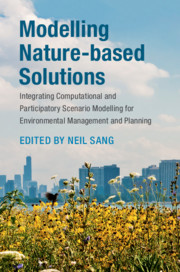 Modelling Nature-based Solutions
Modelling Nature-based Solutions Published online by Cambridge University Press: 13 March 2020
Agent-based models are dynamic computer simulations that explicitly represent the interactions of heterogeneous individuals. Interest in such models stems from a number of disciplines. Some economists see agent-based models as enabling them to escape the restrictive assumptions of human rationality needed for tractable mathematical analysis under the classical paradigm, among other reasons (Axtell, 2000). Indeed, the broad affiliation of disciplines interested in a ‘complex systems’ perspective, in which systems of multiple interacting heterogeneous elements generate ‘emergent’ structure and order at the aggregate scale, offers a new metaphor for understanding economic systems. Arthur, Durlauf and Lane’s (1997) introduction to The Economy as a Complex Evolving System, for example, cites various features of real economic systems that are challenging to classical analysis, but entirely natural from a complex systems perspective: e.g. out-of-equilibrium dynamics, dispersed interaction and the lack of a global mediator. Agent-based models are closely aligned conceptually to a complex systems view of the world. Broader interest in agent-based modelling in the social sciences is derived from its perceived potential as a ‘third way’ between the quantitative and qualitative camps (Moss, 1999). The conceptual chasm between these two is often overemphasised, with most pragmatic social scientists willing to adopt mixed-methods approaches to case studies, but if seen as a formal environment in which to explore the dynamic outcomes of more assumptions than the human mind can reason with logically, agent-based models offer qualitative social scientists new tools to explore their findings, which can potentially be fitted to data gathered and analysed by quantitative social scientists. Geographers are interested in agent-based models because they can be used to represent space explicitly.
To save this book to your Kindle, first ensure no-reply@cambridge.org is added to your Approved Personal Document E-mail List under your Personal Document Settings on the Manage Your Content and Devices page of your Amazon account. Then enter the ‘name’ part of your Kindle email address below. Find out more about saving to your Kindle.
Note you can select to save to either the @free.kindle.com or @kindle.com variations. ‘@free.kindle.com’ emails are free but can only be saved to your device when it is connected to wi-fi. ‘@kindle.com’ emails can be delivered even when you are not connected to wi-fi, but note that service fees apply.
Find out more about the Kindle Personal Document Service.
To save content items to your account, please confirm that you agree to abide by our usage policies. If this is the first time you use this feature, you will be asked to authorise Cambridge Core to connect with your account. Find out more about saving content to Dropbox.
To save content items to your account, please confirm that you agree to abide by our usage policies. If this is the first time you use this feature, you will be asked to authorise Cambridge Core to connect with your account. Find out more about saving content to Google Drive.